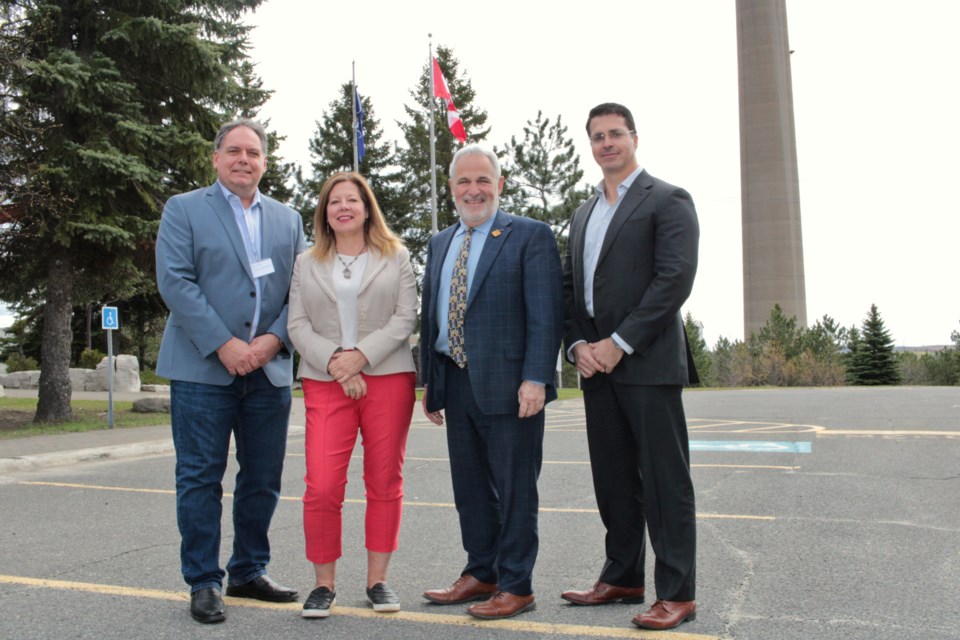Glencore’s $1.3-billion Craig Onaping Depth Mine expansion has received an $11-million boost from the federal government toward the purchase of electric vehicles.
Local Liberal MPs Marc Serré (Nickel Belt) and Viviane Lapointe (Sudbury) visited Glencore Sudbury Integrated Nickel Operations in Falconbridge on May 10 to make the announcement.
“This investment is providing not only workers but also our greater community with a safer, cleaner and healthier environment,” Lapointe said, crediting Glencore as being “true leaders” when it comes to taking responsibility for environmental stewardship.
The Depth Mine is reaching approximately 2.6-kilometres into the ground, below the existing Craig Onaping mine. Its vertical shaft has recently been completed.
“Toward the end of this month we’re going to start the official development off-shaft,” Glencore Sudbury Integrated Nickel Operations vice-president Peter Xavier told Sudbury.com following Friday’s announcement. Construction is expected to continue into 2026.

Of the $1.3-billion mine expansion expense, approximately $100 million is being spent on the initial round of electric vehicles which Xavier said have served as “a big enabling piece” in getting the project rolling.
Lacking the emissions of diesel-powered vehicles, he said electric equipment requires less air being pumped underground, which needs to be heated as it enters during the winter and cooled throughout the year at an underground refrigeration plant due to hot temperatures at that depth.
This is where most greenhouse gas emissions come from, he said, which is significantly lessened by the use of electric vehicles.
It’s been a long road to get to this stage since Glencore made the decision to go all-electric with the Depth Mine, Xavier said during Friday’s funding announcement.
“The market could not deliver the equipment that we needed for this mine, so we had to make a pretty serious commitment and take a bit of a risk to push the industry in that direction,” Xavier said.
This industry-wide push, Serré said, will have wider-reaching implications as other mines adopt the electric-vehicle technology Glencore helped push original equipment manufacturers to produce.
More will be needed, Xavier said, affirming, “Ultimately our future is at depth,” where electric vehicles make economic and environmental sense.
The $11-million boost from the province is a significant help, he said, noting that producers in other countries are able to extract nickel from the surface at a much lower cost.
“The nickel, just because it’s hard to get doesn’t, make it more valuable, so we still have to figure out how to sell it at the market price despite the challenge and higher intensity needed to get at those depths,” he said.
“The cost and effort to get us to this point to even have this as a viable option was a lot, so that was very helpful and I think it’s a signal to the marketplace to continue to innovate on the EV side of things.”
The federal funds come from the carbon tax — specifically, carbon tax paid by industrial users, with industry paying for industry electric-vehicle innovation, Serré explained. The funds come from the Decarbonization Incentive Program, which is fed by carbon tax dollars from industrial sectors (other than the electricity sector).
The use of electric vehicles at the Craig Onaping Depth Mine expansion is estimated to reduce more than 5,500 tonnes of greenhouse gas emissions in 2030, which Serré said is the equivalent of 1,600 cars and the equivalent of 57 trips to the moon.
The mine is expected to carry a lifespan until 2040, with possible extensions depending on what miners find underground.
Tyler Clarke covers city hall and political affairs for Sudbury.com.




